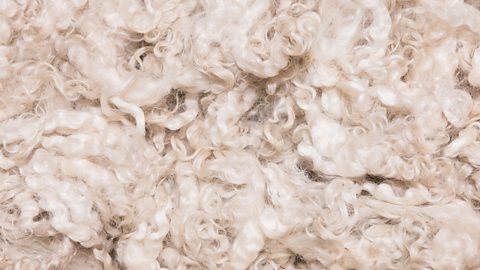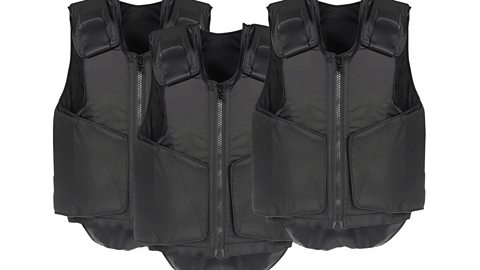Sources, origins and properties
Most textile materials originate from a single, fine structure called a fibreSingle, hair-like strands that derive from either natural or synthetic sources.. Some fibres are naturally short in length and are known as staple fibresShort, usually natural, fibres before they are spun into threads., eg cotton, wool and linen. Other manufactured (synthetic) fibres are known as continuous filamentA fibre that is long in length. Synthetic fibres are all of a continuous filament., eg polyester and nylon.
Natural polymers (natural fibres)
natural polymerNatural fibres that come from plants, animals or insects., also known as natural fibres, come from animals, insects or plants. They all biodegradeAbility to biologically break down. so are sustainableA sustainable resource can be replaced once used. As a tree is chopped down, many more can be planted to ensure the use of trees can be sustained. , although the processing uses energy.
Wool (animal)
Wool fibres come from the fleece of a sheep, which are shornThe process of shearing the wool from a sheep once a year. every year during the summer. The fibres:
- are staple (short)
- have a wavy appearance, called a crimp, which traps air easily giving them excellent insulation properties
- have good crease resistance, so are commonly used to make jumpers, blankets and suits
- are expensive
- can easily shrink if washed in hot water
Wool fibres can come from rarer sources, such as mohair or cashmere (both from goats), angora (rabbit), alpaca and camel, and all have similar propertiesThe mechanical, physical or optical properties of materials that define how they behave in use..

Silk (insect)
Silk fibres are produced by a silkworm, which spins itself into a cocoon structure before becoming a silkmoth.
The fibres:
- are harvested from the cocoon as a filament fibre, a time-consuming process.
- are costly and are made into luxury clothing, eg evening dresses
- have a natural sheen, called lustre
- are highly absorbent so comfortable next to the skin
- crease easily

Cotton (plant)
Cotton is found in the seed bollA protective case around the seeds (and fibres) of the cotton plant where cotton fibres are found. of the cotton plant and is the most widely used of fibres around the world. The fibres:
- are highly absorbent so are comfortable next to the skin
- can be washed easily at high temperatures
- have good tensile strengthTensile strength is the ability of a material to resist pulling forces without snapping, eg a guitar string has high tensile strength.
- are durable
- crease easily
Cotton is commonly used for all types of clothing and furnishing fabrics. Other seed fibres include hempFibres that are four to five times longer than wood and originate from a variety of the cannabis plant. and juteA natural fibre from the stems of a tropical plant, used for making twine, rope and woven sacking material.. These fibres have similar properties to cotton and tend to be used for carpets, upholstery, bags and rope.
Linen (plant)
Linen is a seed fibre from the flax plant and has similar properties to cotton. The fibres are:
- very strong
- more durable than cotton
- equally as absorbent as cotton
It is used for summer clothing, keeping the wearer cool and for furnishing fabrics.
Manufactured polymers (synthetic fibres)
Manufactured polymers, also known as synthetic fibres, are made from synthetic sources, such as oil, coal or petrochemicals, or naturally sourced materials which undergo a chemical process.
They are made into simple chemical molecular chains, called monomers, which join together to form polymers.
The fibres:
- melt when exposed to heat
- can be made any length or any thickness
- donтt biodegrade easily
Polyester is a very common manufactured fibre used for clothing as it is easy to care for, dries quickly and is very strong. It is water resistant (has poor absorbencyAn ability to hold a liquid such as water.) and crease resistant.
Nylon is similar to polyester but is more durableHardwearing.. It is used for carpets and outdoor textiles, such as tents and rucksacks.
Acrylic is manufactured to resemble wool, with an added crimp. It isnтt as insulating as wool but it is much cheaper to produce. It has poor absorbency so dries quickly and is used to produce jumpers and fake fur products, like coats.
Polypropylene is particularly strong and durable. It is usually manufactured for specific end uses, such as fishing nets, sacks and rope.
Elastane has high elasticity and is always mixed with other fibres, particularly those that crease badly like cotton. It is used to produce fabrics for sportswear to ensure a tight fit.
Aramid fibres are manufactured for specific end uses, eg Kevlar (bulletproof vests) and Nomex (firefightersт outfits). Both are resistant to heat and extremely strong, and they are often blended together to combine their properties.

Image caption, Image caption,
1 of 2
Microfibres are very, very fine - they are difficult to see with the naked eye. Consequently, they are lightweight with good draping qualities and are made into silk-like fabrics. Examples include:
- tactel - a nylon-based fibre, not absorbent
- tencel (or Lyocell) - highly absorbent, doesnтt crease, a regenerated microfibre made from wood pulp, so it is biodegradable
Blending and mixing
As fibres have varying properties, they are often blended or mixed with other fibres to improve their performance:
- Blending - takes place at the fibre stage and often decreases the cost of the fabric. A common example is polycotton, a blend of cotton and polyester fibres. Cotton creases but is highly absorbent, whereas polyester isnтt absorbent but doesnтt crease. By blending these fibres, you get a fabric that has improved properties and therefore more extensive end uses.
- Mixing - takes place at the yarnShort threads spun to form one long thread. and fabric construction stage, with different yarns used for the warp and weft to change the properties and characteristics of the fabric. Cotton is often mixed with elastane, to prevent creasing but also to aid the fit of a garment, and is used in sportswear and jeans.